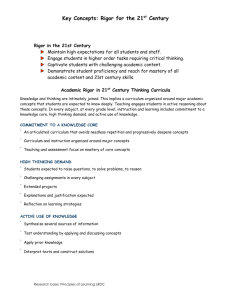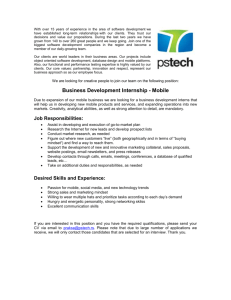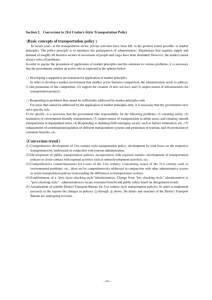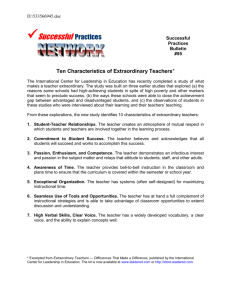21st Century OrganizatiOn
advertisement
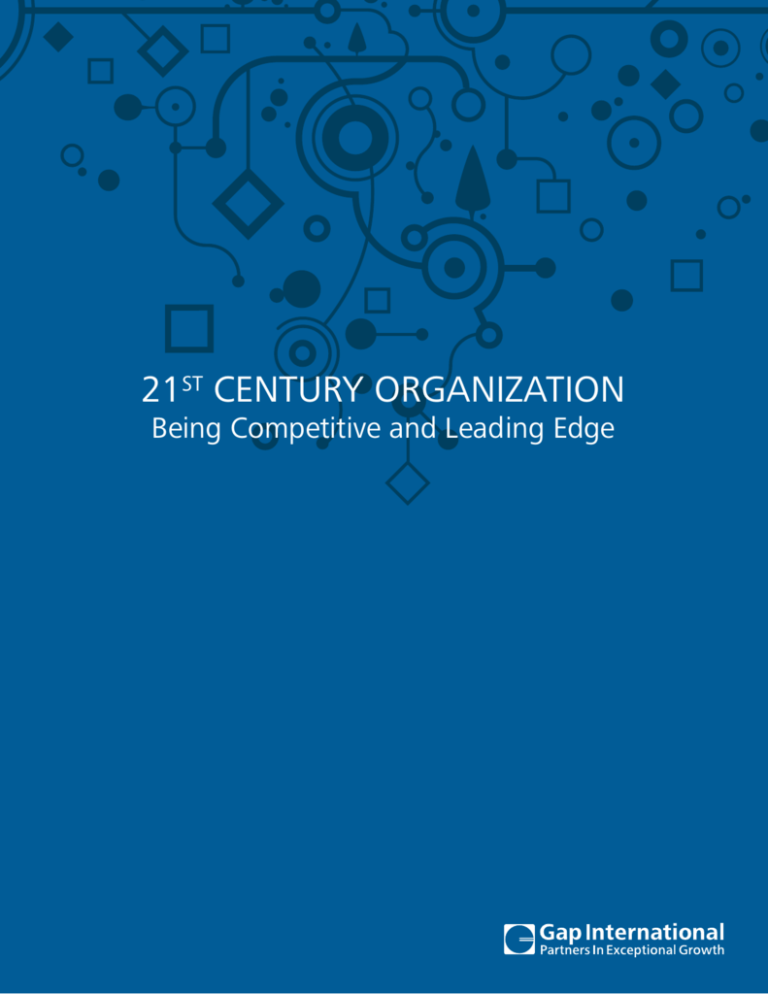
21st Century Organization Being Competitive and Leading Edge The 21st Century Organization Being Competitive and Leading Edge Today’s business environment can be characterized by two primary influences. The first is the accelerating pull towards commoditization, which requires organizations to continuously stretch and maneuver for differentiation. Almost anything an organization produces can be quickly imitated or improved, and first-to-market advantages have short life-cycles if any at all. Digitalization, informationsharing and vast productivity increases have evened the playing-field in many markets. Business leaders find themselves under pressure to compete purely on price as competitors begin to capture customers using different business models and innovative ways to create new value. The second influence is the continuous uncertainty in markets, along with the day-to-day game to survive in changing and unknown environments. The interconnected nature of countries, continents and global markets underlies a delicate domino effect where local success or failure impacts the whole system. Markets, competitors and customers all change quickly, and these changes continue to accelerate faster than organizations are able to formulate a response. Strategic plans quickly become stale or outdated. Decisions must be made with incomplete information. Furthermore, complexity makes it harder to discern what is truly critical. Successful firms face wholesale shifts in their markets, where the entire reality has seemingly changed overnight and previously successful activities have to be completely reframed. Along with these macro-changes, the internal dynamics of most organizations have completely changed as well. The modern employee no longer seeks one organization to sustain their career. The search for stability and longevity has been replaced with a hunger for interesting projects and a thirst for meaning and fulfillment of far more importance than the reward of a paycheck. The shorter attention span, fickle pursuits and self-interest of employees all compete with their ability to focus their full energy on the success of the organization. In addition, leaders must manage generational differences, the need to constantly build a variety of skill sets, diverse personal concerns and the appeal of greener pastures. Therefore, competition for employee attention and full engagement can be as intense as the competition for the best and most profitable customers. Every modern business leader is experiencing a higher level of ambiguity and uncertainty than leaders of the past have faced, with the probability that this complexity will only continue to increase. Consequently, organizations will need to bring a fresh approach to their markets, with unprecedented creativity and resilience to stand out and attract customers and talent in order to thrive. As a leader committed to creating and growing a successful 21ST Century Organization, the important question becomes: What do you focus on now to be competitive and leading-edge? We have found that the following six pillars provide a useful framework to think about this question. Relentless Innovation Product innovation alone will create insufficient competitive advantage. In looking at this, we are discovering that leaders can substantially differentiate their organizations by developing an expanded platform for relentless innovation. Rather than relying only on innovation departments to improve product cycles, companies focused on 1 relentless innovation foster this kind of thinking in all areas of the business. We have seen that unless leaders systematically innovate in every corner of the business, including supply chain, talent development, sales process, strategic planning and customer engagement, the organization will not be able to keep up with market demands and competitive pressures. Relentless Innovation requires a new mindset – one that liberates everyone in the organization to become innovators and create differentiation, regardless of position or function. This includes moving away from the idea that only a few creativetypes possess the special capability to innovate. Rather, consider that everyone can learn to be innovative in all aspects of the organization. An eye on having everyone innovate everywhere opens the door for remarkable edge in the marketplace. Being Purposeful The 21ST Century Organization can also differentiate itself by operating within a bigger context than a vision or a mission, something more expansive. It’s not enough anymore to simply have a clear direction – people must be able to throw their entire selves into the game to be successful, with full engagement of heart and mind. We have found that when leaders leverage Purpose, it creates a competitive advantage that’s difficult or even impossible to replicate. Purpose creates the ability for people to care about something much bigger than their personal concerns and fully apply their talent to meaningful endeavors. If you think about it, Being Purposeful creates the platform for organizational success, because it taps into a reservoir of potential energy latent within the organization. When people’s orientation to their job transforms from performing work to that of making a difference, they become exponentially more effective at coming together to produce extraordinary results. It becomes possible to consistently produce results beyond what is predictable in the normal flow of business. Powerful strategies can be created and re-created when purpose is present. Purpose gives people a far more expansive space to create and grow, where creative, purpose-based thinking replaces crisis-based, firefighting thinking. An organization of people who have connected themselves to something bigger can thrive rather than simply survive – they can move fast together and nimbly adjust strategies and tactics to succeed. 21st Century Leader We have seen that Relentless Innovation and Purpose position the organization for increased success, yet uncertainty and accelerating competition have also shaped the need for a new kind of leader. It seems that past paradigms of leadership have begun to dissolve away, and the hierarchical, command-and-control boss who directs an organization’s activities from a point of authority will no longer be acceptable. In addition, merely building consensus also seems to be losing its effectiveness. A good question to ask then is what kind of leadership does my organization need from me? We see the 21ST Century Leader as someone who regularly takes bold stands and delivers extraordinary results, bringing everyone around them to a higher level of performance. They focus on connecting people to purpose and aligning multiple groups from every direction. They are authentic and open. Leaders like this bring out the best performance, creativity and expression in everyone. 21ST Century Leaders inspire their people and organizations to confidently take on the biggest challenges in the marketplace, even when it’s not yet obvious how to win. They commit to goals they don’t know how to accomplish, which challenges people to change their thinking in order to grow and deliver. They see how their own growth 2 connects to performance, and they demonstrate humility in knowing that they, just as everyone else, must constantly grow and expand themselves to develop the next level of competitive edge. To thrive in the uncertainty, these leaders cultivate the capability to create amazing relationships with anyone, including customers, employees, regulatory institutions and shareholders. It’s exciting to be around this kind of leader and it’s just what the world needs – a leader who combines a resolve for amazing results with heart and humanity. These leaders attract the best people who want to make a remarkable impact in the marketplace. Passion for Growth In our way of looking at it, truly everything can grow, and for a 21ST Century Organization, leaders can benefit from attending to a wider view of what must grow. A mindset that we have found to be critical is what we call Passion for Growth, where everyone growing and breaking through limits becomes just as essential as growing the top and bottom line. In uncertain and changing markets, predictable sources of growth can instantly become unpredictable, so it is important for organizations to find ways to stretch into uncharted territories for growth and bring a willingness to take on even the most hopeless challenges. If you think about it, at any moment an organization is either growing or declining – there is no middle ground. Having a Passion for Growth opens the eyes of the organization to a vibrant view of the marketplace – seeing realities that need to be dismantled and re-created in order to compete. Instead of waiting for current success to dwindle, leaders and organizations with Passion for Growth seek out opportunity everywhere, applying creativity and curiosity to all aspects of the business. Creating a Passion for Growth connects people to an exciting future – one that has endless possibilities to pursue. In this environment, it becomes important for everyone to contribute to and grow each other, having tapped into the inherent pride of being part of something amazing. This mindset of Passion for Growth underlies the mindset for being a leading-edge organization. Customer Oneness Along with leadership and growth, we are seeing that an entirely new mindset about customer relationships is necessary for the 21ST Century Organization – that of being one with the customer. Historically, the customer framework has mostly focused on customer service, fulfillment or even obsession, where the company takes care of determining and fulfilling customer needs in the best way possible. This frame of mind is limited by the ability of one entity to serve another. We suggest that being one with the customer initiates a connection where no separation exists, and therefore everything consistently begins and ends with the customer. What’s different about Customer Oneness is it significantly expands the typical appreciation and understanding of the customer. Being the customer gives an organization a precise perspective, one that is needed to create amazing products and services over and over. When an organization thinks and operates as its customer, the future is shaped as the customer, not just for the customer. It is possible for any organization to create this kind of relationship – where customers naturally become part of creating new and desirable offerings, therefore accelerating innovation. Customers become drawn to and will stand for the success of organizations that operate with Customer Oneness. Why wouldn’t you absolutely support an organization whose people think from your perspective and are so keenly in tune with your wants and needs? Embraced and institutionalized throughout the organization, this mindset generates a constant edge in the marketplace. 3 Breakthrough Environment Finally, successful 21ST Century Organizations can reformulate their work environments into Breakthrough Environments – environments which flex to support the rapid movement, speedy decision-making and alignment required to outperform competitors and regularly achieve extraordinary outcomes. We have seen that once leaders develop new access to creating alignment among leaders and teams, they can successfully navigate ambiguity at all levels and pursue the biggest possibilities for the organization. The normal organizational approach focuses on generating outputs, such as profit and productivity, from the environment. The intention to create a Breakthrough Environment expands the mindset to focus on very specific inputs for the environment that result in extraordinary outputs. Well-nurtured internal interactions between leaders and teams give a precious advantage with speed, reliability, quality, engagement and innovation. The inputs to these are affinity, ownership, interdependence, purpose and risk. Any organization that measures and attends to these specific inputs over time can create a competitive platform for sustainable growth and performance. Having an environment where people can achieve their best performance, as well as continue to challenge themselves and grow, allows for an organization to be successful, attractive and edgy in the marketplace. Incorporating the mindset of all Six Pillars as expressed above gives leaders access to generating extraordinary performance in a changing world. Even the most daunting of circumstances give us all the opportunity to grow and perform at higher levels, and these pillars outline a pathway for approaching such challenges and building an amazing edge to compete and succeed in the marketplace. Knowledge emerges and alters, trends suddenly change, attitudes completely reverse and market realities give way to new realities. In all of this constant turmoil, the best organizations will continue to nurture their most precious asset – their people – with the unrelenting commitment for exceptional performance. Over time, the brilliance of the organization becomes increasingly expressed through new mindsets, environments and leadership. Understanding and integrating the next generation principles of Relentless Innovation, Being Purposeful, 21ST Century Leader, Passion for Growth, Customer Oneness and Breakthrough Environment will give 21ST Century Organizations committed to producing amazing results the platform to thrive into the future. It all starts with a leader taking a stand for an extraordinary organization, a choice that any leader can make. where do we go from here? The competitive requirements of the 21ST Century will only continue to change and evolve into challenges we aren’t necessarily ready for. We must consider together that what has made us successful to this point will likely be insufficient for future success. The willingness to question the assumptions that have made us great will allow us to create greatness in the years to come. 4 ABOUT THE AUTHOR AND GAP INTERNATIONAL Pontish Yeramyan is the founder, President and CEO of Gap International, a global management consulting company that partners with executives in producing exceptional growth through extraordinary performance. Gap International offers innovative products and services that provide a disciplined, systematic approach to sustainable profitable growth. Ms. Yeramyan created the company with a commitment to having organizations fulfill their purpose and make a profound difference in the world. While driving the firm’s expansion, she consults CEOs of FORTUNE and Global 500 companies in designing and executing breakthrough growth and performance strategies. Ms. Yeramyan has personally impacted hundreds of executives and leadership teams over the course of her career, measurably and dramatically improving their financial, market and organizational results. Ms. Yeramyan received a B.A. in Psychology and Linguistics from Barnard College and an M.A. in Linguistics from Michigan State University. Click here to view Pontish Yeramyan’s 21ST Century Organization video series 5 Gap International 700 Old Marple Road Springfield, PA 19064 USA +1 610 328 0308 gapinternational.com © Gap International September 2011


